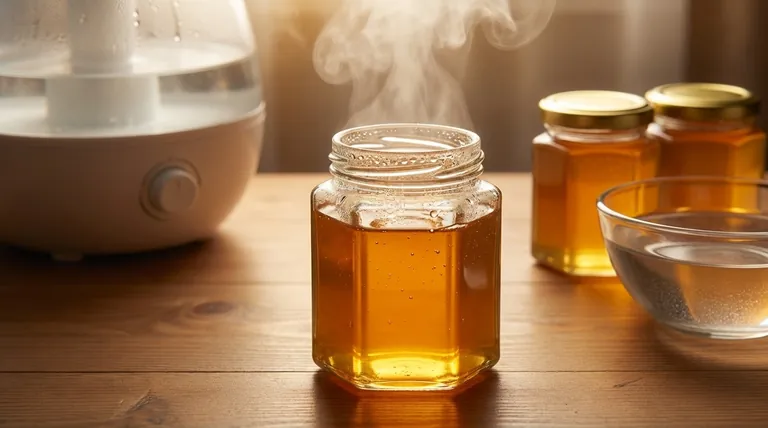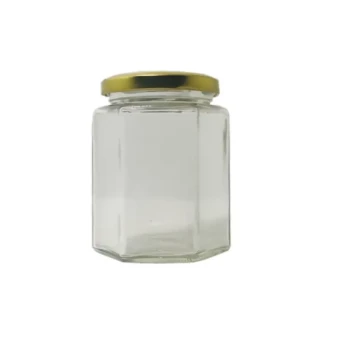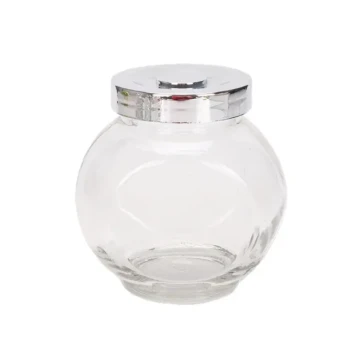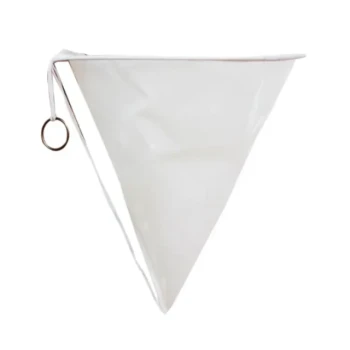The term for honey's ability to absorb moisture directly from the air is hygroscopy. This is a fundamental chemical property driven by honey's unique composition—a supersaturated solution of sugars with very low water content. This characteristic is central to understanding both its incredible shelf life and its behavior in cooking and storage.
Honey's hygroscopic nature is a double-edged sword. While this moisture-absorbing quality helps preserve it by dehydrating microbes, it also makes honey vulnerable to fermentation if not stored in a sealed container.

What Makes Honey Hygroscopic?
Hygroscopy isn't unique to honey, but honey is one of the most powerful hygroscopic substances found in nature. This property is a direct result of its chemical makeup and the physics of water activity.
A Supersaturated Sugar Solution
Honey is composed of roughly 82% sugar (primarily fructose and glucose) and only about 17% water. This creates an extremely dense, supersaturated liquid. There are far more sugar molecules than there are water molecules to bond with.
The Principle of Water Activity
Because the water molecules in honey are so tightly bound to the abundant sugar molecules, they are not "free" to react. This gives honey a very low water activity. The surrounding air, especially in a humid environment, has a much higher concentration of free, unbound water molecules.
Seeking a Natural Equilibrium
Nature always seeks balance. The low-water, high-sugar environment of honey acts like a powerful sponge. It will actively pull the "free" water molecules from the more humid air in an attempt to equalize the moisture concentration between itself and its surroundings.
The Practical Implications of Hygroscopy
This single property has profound effects on how honey is used and preserved, making it both a powerful preservative and a useful culinary ingredient.
For Preservation and Shelf Life
Honey's ability to draw in moisture is its primary defense mechanism. When bacteria or yeast land on honey, the hygroscopic action immediately pulls the water out of their cell walls, dehydrating and killing them before they can spoil the honey. This is a key reason honey is so resistant to spoilage.
For Baking and Cooking
In the culinary world, hygroscopy is a benefit. When used in baking, honey acts as a humectant, drawing moisture from the recipe and the air into the final product. This results in baked goods, like bread and cakes, that remain moist and fresh for much longer than those made with other sweeteners.
Understanding the Trade-offs: The Risk of Fermentation
While hygroscopy protects honey, it can also be its downfall if managed improperly. The same process that kills microbes can, under the right conditions, lead to spoilage.
When Absorption Goes Too Far
If honey is left unsealed, especially in a humid climate, it will continuously absorb moisture from the atmosphere. This process gradually increases the water content of the honey.
Dilution and Spoilage
Once the water content in honey rises above approximately 19%, the sugar concentration becomes diluted enough for specific, sugar-tolerant yeasts (osmophilic yeasts) to survive. These dormant yeasts can then activate and begin the process of fermentation, turning the honey's sugars into alcohol and carbon dioxide, effectively spoiling it.
The Critical Need for Sealing
This vulnerability is why proper storage is non-negotiable. An airtight container creates a barrier between the honey and the ambient air, preventing moisture exchange and keeping the water content stable and safe.
How to Manage Honey's Hygroscopic Nature
Understanding this property allows you to control it for your specific goal, whether you are storing honey, baking with it, or harvesting it.
- If your primary focus is long-term storage: Always keep honey in a sealed, airtight container in a dry place to prevent moisture absorption and fermentation.
- If your primary focus is baking: Leverage honey's hygroscopic nature to create exceptionally moist baked goods with an extended shelf life.
- If your primary focus is beekeeping: Ensure honey is cured to a low moisture content (typically below 18.6%) before harvesting to guarantee its long-term stability.
By managing its exposure to air, you can harness honey's unique properties while completely avoiding its potential for spoilage.
Summary Table:
| Property | Description | Key Implication |
|---|---|---|
| Hygroscopy | Honey's ability to absorb moisture from the air. | Preserves honey by dehydrating microbes; requires airtight storage to prevent fermentation. |
| Low Water Activity | High sugar concentration leaves little free water. | Creates an environment that draws moisture from the air or other substances. |
| Humectant in Baking | Hygroscopic nature helps retain moisture. | Keeps baked goods fresher and softer for longer. |
Harness the Science of Honey with HONESTBEE
As a commercial beekeeper or equipment distributor, understanding hygroscopy is key to producing and preserving high-quality honey. HONESTBEE supplies the durable, airtight storage solutions and harvesting equipment you need to manage moisture content effectively and protect your yield from spoilage.
Let's discuss how our wholesale-focused operations can support your business.
Contact our expert team today to explore our full range of beekeeping supplies and equipment.
Visual Guide

Related Products
- Hexagonal Glass Honey Jars with Metal Lug Caps Elegant Versatile Packaging
- Classic Drum Shaped Glass Honey Jar with Airtight Lid
- Inverted Squeezable Honey Jar with No Drip Flip Top Cap for Easy Pouring
- Professional Cone-Shaped Honey Filter with Reinforced Steel Ring
- Natural Wood Honey Dipper for Tea Coffee and Desserts
People Also Ask
- What is the best way to jar honey? Preserve Quality with the Right Container
- How should honey be stored and packaged? Preserve Flavor & Quality with Proper Containers
- Why is a glass jar preferred for packaging honey? Ultimate Protection for Purity & Flavor
- How many jars of honey do you get from a hive? Unlock Sustainable Harvesting Secrets
- What makes raw honey more aesthetically appealing than processed honey? Discover the Beauty of Authenticity



















